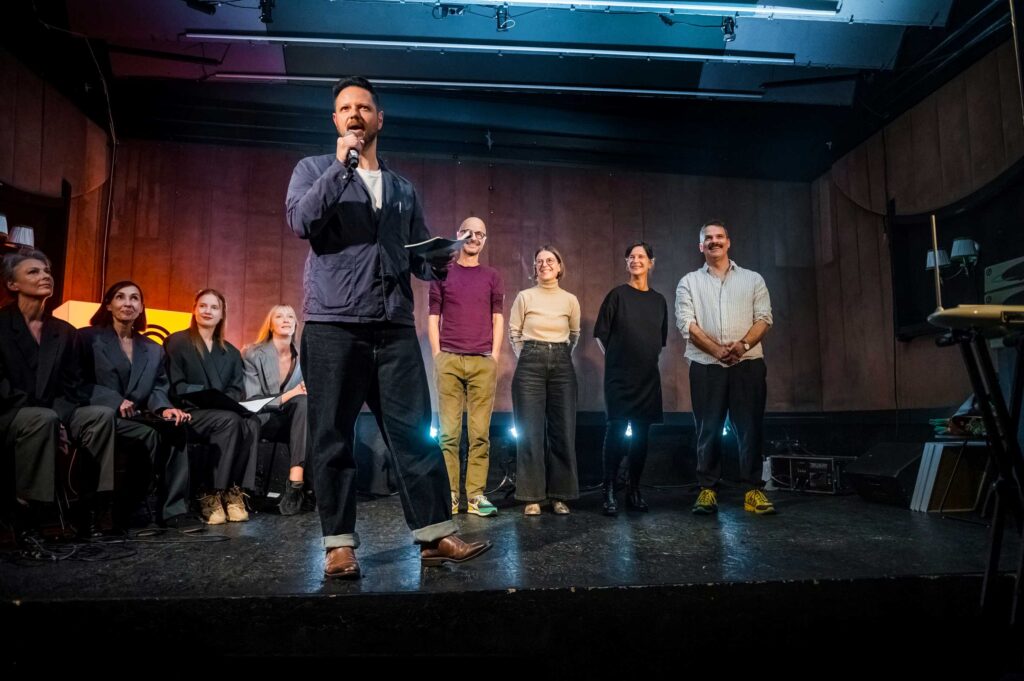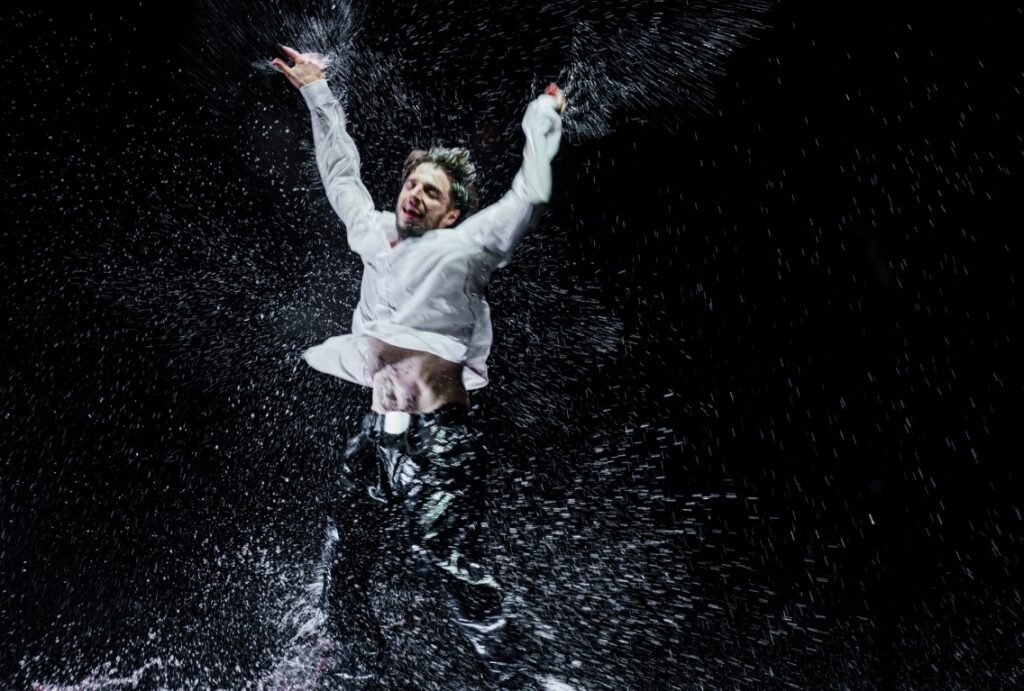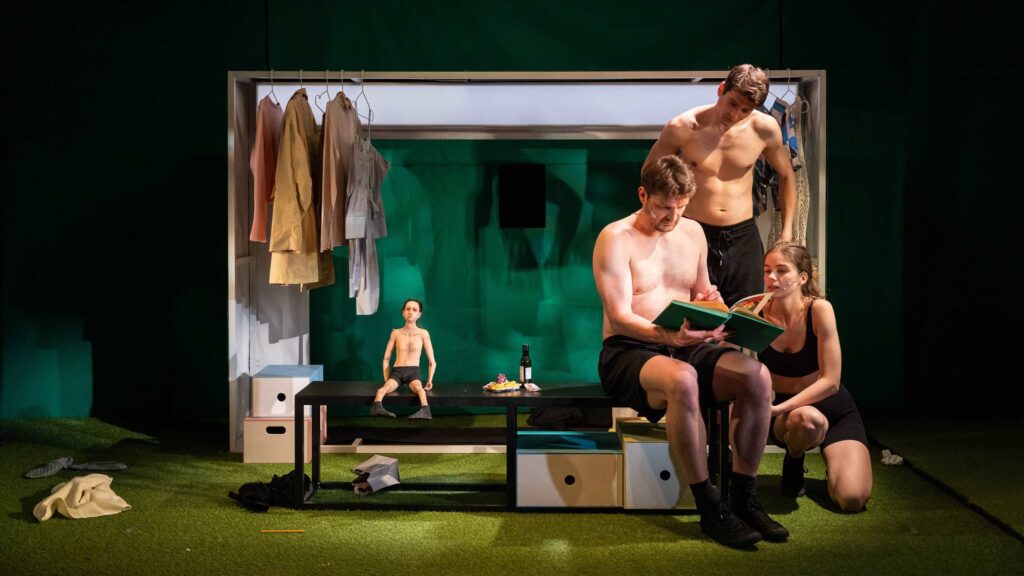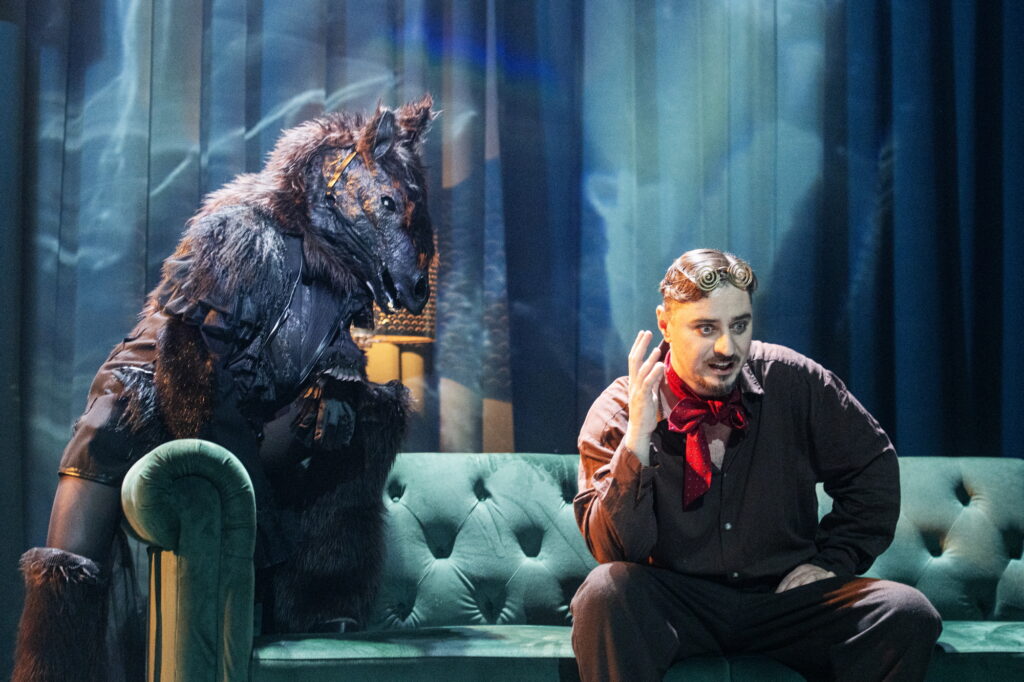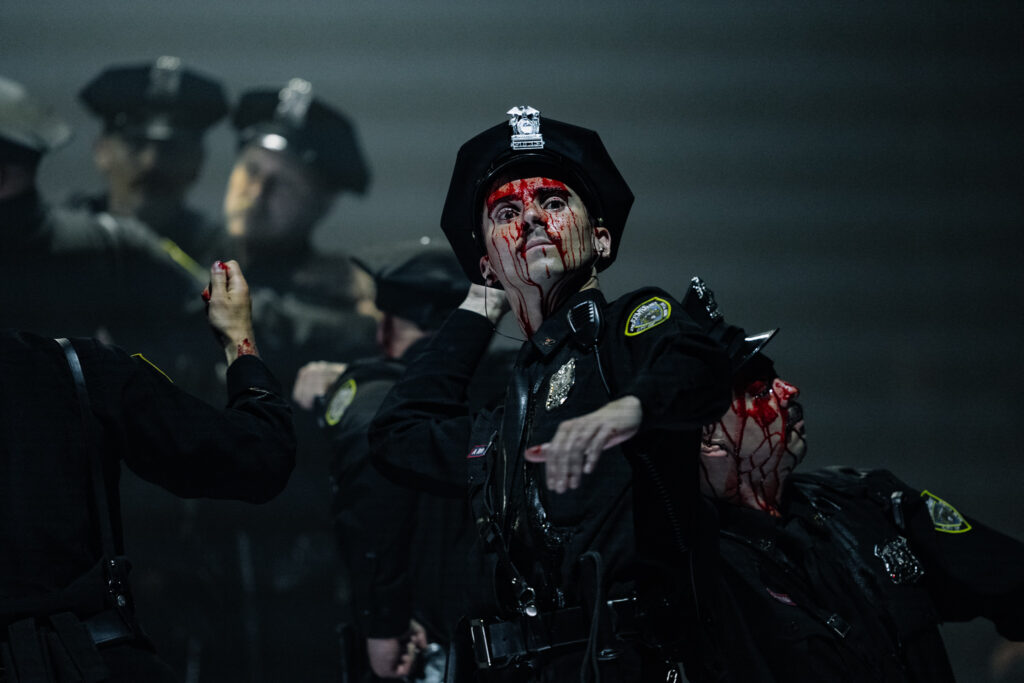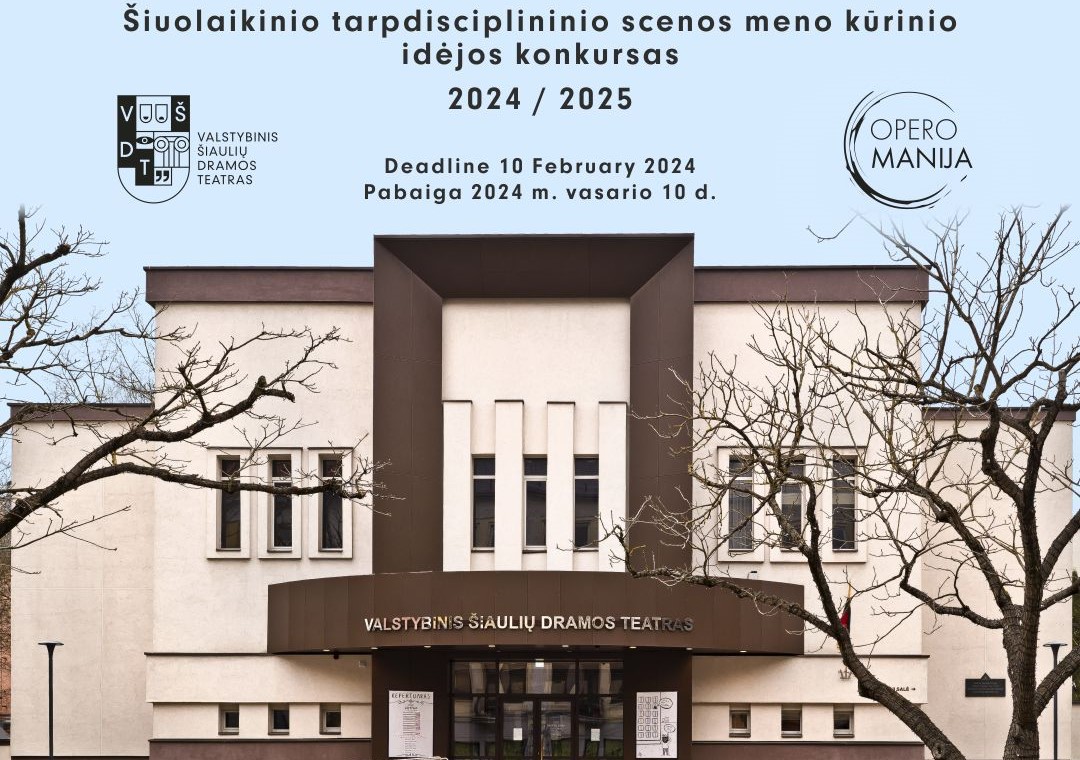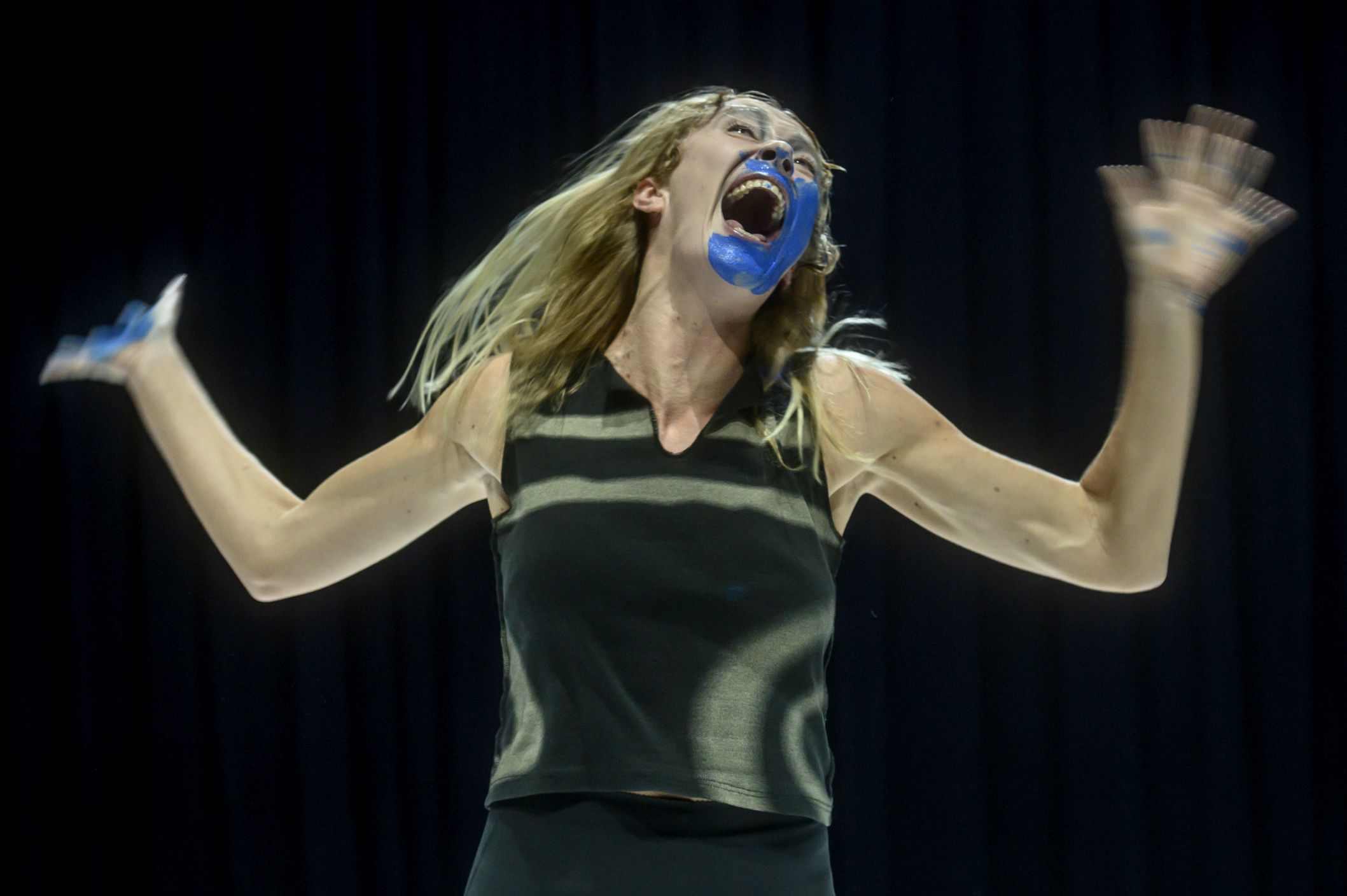Edith, played by Sigita Mikalauskaitė, is dancing. The dance is light, rising above the ground. But there is something wrong with it: lightness and beauty are accompanied by a sense of uncanniness. An actress dressed in black dancing on a dark stage makes it difficult to identify why exactly we feel uncanny. She bounces off the floor, rises, and hovers in the air. At the end of the first scene in the show, she keeps raising her leg until she eventually takes it off. The leg is fake, just like all the other objects appearing in the play. It is made of thermoplastic worbla, which, while incredibly similar to the real thing, is lightweight and translucent. It also does not allow for standing firmly on the ground, dancing away into the realm of memories. This uncanniness might stem from the juxtaposition of the real and the artificial, the living and the prop body, the action that is happening now and the action that is remembered.
This is how The Choice (Vilnius “Lėlė” Theatre, 2022), a production directed by Gintarė Radvilavičiūtė, begins. During the performance, the sole actress present on the stage is going to dance with human and horse body parts, accompanied by landscapes of crumbling, decaying bodies, while the senses of the audience are flooded by multiple waves of uncanniness.
Radvilavičiūtė made her debut as a puppet theatre director in 2004. While her first works were closer to traditional puppet theatre, in her later works for children and adults she started experimenting with various materials and objects, searching for the miracle of revival in household utensils, cutlery and dishes, toys, wire, paper, antiques and light. Her works for audiences of all ages are also united by the fact that the selected literary material in her performances does not act as the main element in the piece accompanying the audience, but rather serves as a pretext for exploring the creative and communicative potential of puppet theatre. Thus, Alfred Jarry's King Ubu became a ballet of legs, arms, tools and vegetables concerned with power relations; E.T.A. Hoffman's The Sandman developed into an experiment addressing diverse ways of joining the puppet and the human body, and investigating the darker side of human nature; while Oscar Wilde's Portrait of Dorian Gray turned into a dance about a longing for light and meaning, featuring miniature plaster replicas of famous sculptures and deformed human bodies.
Radvilavičiūtė and the playwright Virginija Rimkaitė treat the literary material of The Choice in a similar way. The autobiographical book by Edith Eger is important in the production: the author's experience in a concentration camp, her feelings of guilt and the resolution to forgive, are conveyed on the stage via the abstract language of dance and puppetry, and through several extracts from the novel. However, once we distance ourselves from the text and from literature, the historical and personal memory, along with the aesthetics of the inanimate referencing the animate and the investigation of its relation to the living body of the dancer, come to the fore.
This investigation of animate-versus-inanimate, and of real-versus-artificial, is one of the few main sources of uncanniness. The artificial leg that tricks the eye in the first scene in the production is joined by human torsos, busts, heads, arms, a horse's head, and other body parts dangling in space. Mikalauskaitė dances with a bust, a torso or a full-body moulage of a human being, either whole, divided into two parts, or without one leg (puppeteer Gintarė Radvilavičiūtė, set and costume designer Julija Skuratova). All these objects are almost realistic. In the dimmer scenes of the production, one might even start doubting what matter is at work here. But in the scenes chosen by the lighting designer Vilius Vilutis, where the spotlights shine brighter, all those body parts become translucent. Not only that: the stage lights also reveal that the parts are not whole, but rather made up of individual pieces. This disparity of objects, probably determined by the fact that worbla is produced in sheets, becomes an important tool for the investigation of memory in the production. Events, people and objects are not remembered as they were; they are pieced together from various fragments and moments by our memories, which omit details and change shades and contexts. Memories are as real as the objects made of thermoplastic that move alongside and around the actress' body during the performance. However, they only contain as much reality as there is in these light, hollow objects that replicate the shape of the human body and its parts.
The real-versus-artificial relationship is also emphasised by the music, composed by Rita Mačiliūnaitė, consisting partly of a sadly bright sound filling the space, as well as the sounds of Edith's world echoed by various instruments, such as birdsong. Almost half-way through the performance, Mikalauskaitė-Edith stands under a triangle of light and starts slowly waving her extraordinarily elongated arms. Slowly raised and lowered, they resemble the flapping of a bird's wings, and this impression is reinforced by the sounds of the accompanying music, recalling the call of cranes. These hands change the proportions of the actress' body, turning her into a childlike figure, and reminding us of the ballet she used to dance before the horrors of the concentration camp, and of the yearning for her mother, who is no longer there. According to the theatre critic Dovilė Zavedskaitė (Toys of the Holocaust, menufaktura.lt), this yearning, along with the continuous search for the hands of others, is the reason for the elongation of the limbs seen on the stage. It results in a fantastical image, destroying the reality of the human body, splashing with the uncanniness of a broken body and spirit.
The motif of surrendering to a longing for the irretrievable past, and memories that are embedded in the body, and deforming its everyday experiences, is revealed both in the text that inspired the production and through the aesthetic decisions of its creators, which is yet another wave of uncanniness in The Choice. The director herself describes this state of being stuck in the past as follows: 'In real life, you also don't let go of many situations, you keep returning, you keep remodelling, rearranging, and changing them. Although logically you realise that it is gone, it all keeps coming back in your mind.' The production emphasises this state through a fragmented narrative made up of different (emotionally, in terms of movement and music) scenes that do not necessarily connect with each other, reminiscent of a restless, easily provoked human memory. This impression is reinforced by the body fragments surrounding Mikalauskaitė, which fill the space of the stage and disappear again, the torsos dancing with the actress, her twists and turns, as if swirling in a spiral of time, together with the disappearing, returning and changing fragments of remembered people, and the constantly watching faces stamped into the monumental wall that will never be forgotten.
The historical context of the play's narrative and creation is similarly uncanny. Speaking about the past, recalling the Holocaust and its consequences, which can even be felt within the walls of the “Lėlė” Theatre, which in 1942 and 1943 housed the ghetto theatre, the creators of the play talk about the present, about ourselves, not only as individuals reflecting on the choices we make in our personal lives, but also as a society that is involved in making daily decisions that are of significance to our neighbours, friends, children, fellow citizens, the people with whom we share the planet, and future generations. The uncanniness arises from the fact that, despite the knowledge of history and the witnessing of it with our genetic codes and the memory of bodies and places, humanity plunges headlong into a repetition of its most horrific episodes, and experiences a constant desire to take revenge on its perpetrators, trapping it in an endless spiral of suffering.
Having highlighted the relationship between the living person and the object that embodies the pain of memory, the motif of the constantly haunting memory, along with the repetition of history (our curse, apparently), the director stresses: 'We cannot choose a life without pain. But we can choose to be free, to free ourselves from the past, no matter what has happened to us, and to make the most of our potential. Learn to live, to forgive each other, and to help others do the same.' This is what Edith Eger teaches us with her life, her book, and her work. This is what Mikalauskaitė teaches us with the final dance in the performance. This is what the whole production team proposes at the end of the narrative, by chasing away the shadows of memories, and opening the way for a person to live with free hands, a free chest and an open glance towards the future. This way, at the very end of the performance, she throws a life ring to the audience, suggesting we do not drown beneath the waves of uncanniness.
Publikaciją finansuoja Lietuvos kultūros taryba

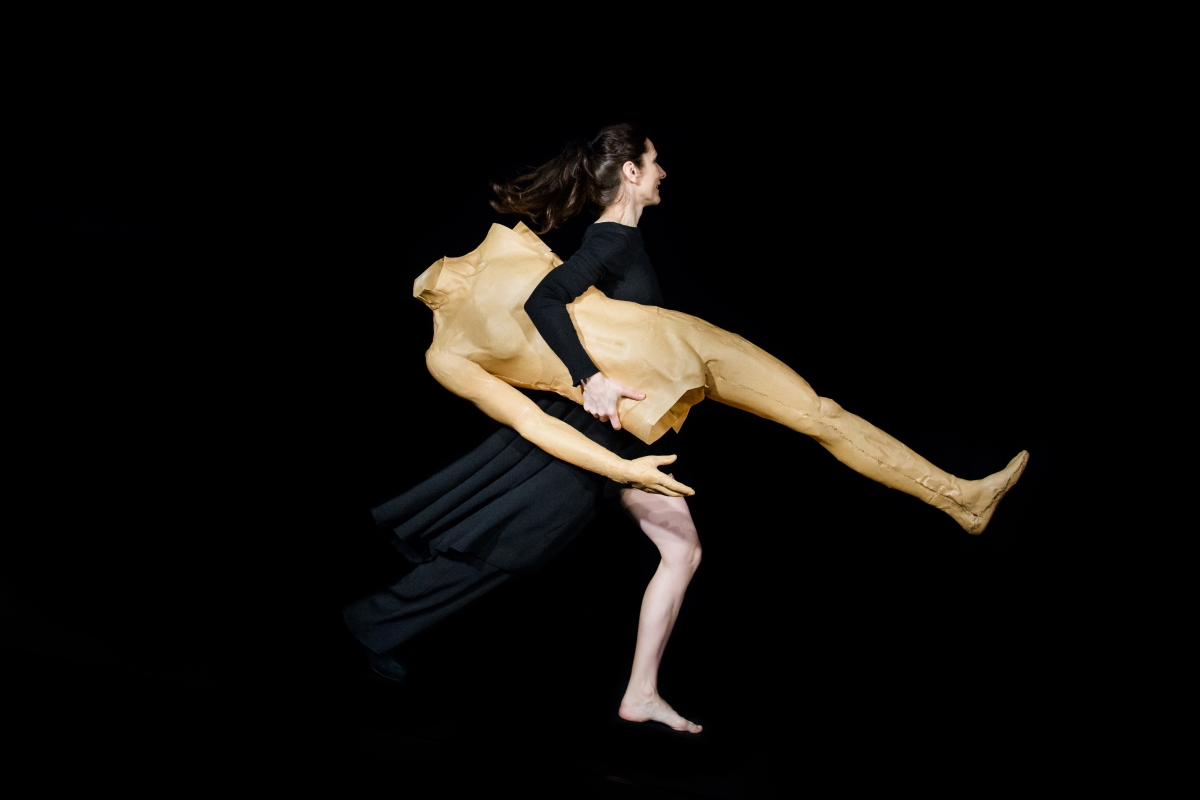

.jpg)
.jpg)

